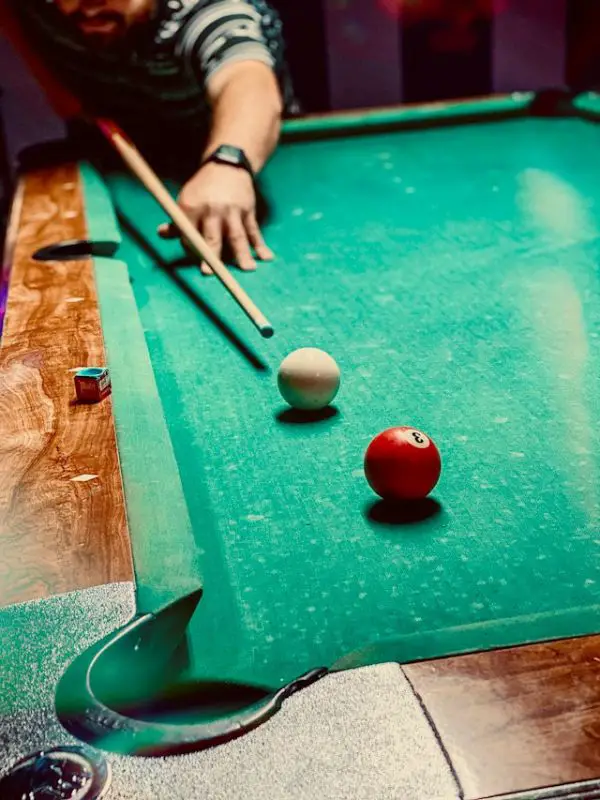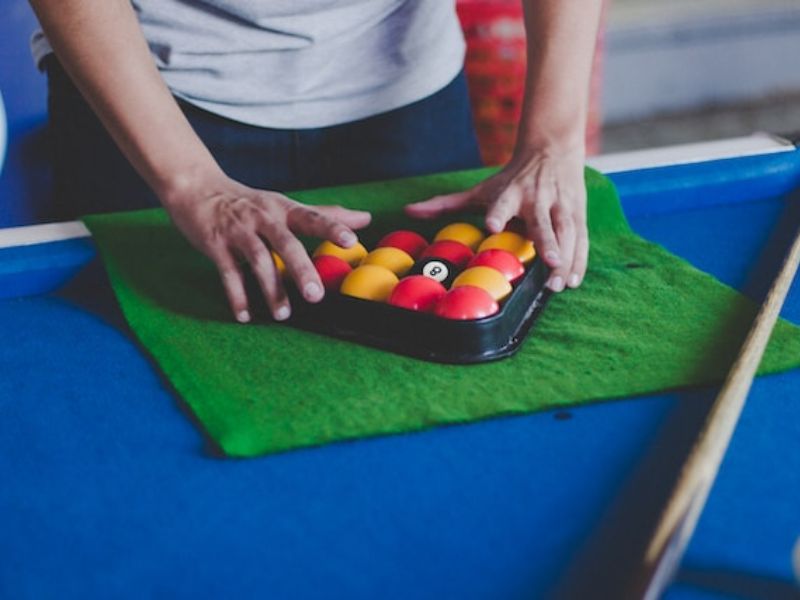Billiards is a diverse world of cues, balls, and tables, offering a plethora of games for enthusiasts to dive into. Two of the most popular cue sports, pool, and snooker, often leave beginners scratching their heads, wondering about the differences between the two.
Unraveling the Mysteries: Pool vs. Snooker – A Comprehensive Guide

In this comprehensive guide, we’ll delve deep into the world of pool and snooker, exploring their origins, rules, and the nuanced distinctions that set them apart.
Pool vs. Snooker
| Aspect | Pool | Snooker |
|---|---|---|
| Table Size | 7, 8, or 9 feet | 10 to 12 feet |
| Number of Pockets | 6 (4 corners, 2 sides) | 6 (corners and middle of long rails) |
| Cloth Type | Faster | Finer |
| Number of Balls | 16 numbered balls | 21 (15 red, 6 colored) |
| Game Variations | 8-ball, 9-ball, others | Standard snooker, variants exist |
| Scoring System | Varied based on game type | Standardized point system |
Understanding the Origins:
- Pool: Pool, often referred to as pocket billiards, has a long and fascinating history. Its origins can be traced back to the 15th century in Europe. Initially played as a lawn game similar to croquet, pool migrated indoors and evolved into the pocketed game we recognize today. The term “pool” itself is thought to derive from the French word “poule,” meaning hen, as players would contribute money to a pool and the winner would take the entire sum, a system reminiscent of a shared meal where each participant adds something.
- Snooker: Snooker, on the other hand, has a more recent inception compared to pool. Developed in the latter half of the 19th century by British officers stationed in India, snooker’s name comes from a slang term for inexperienced personnel. The game quickly gained popularity and made its way to England, where it underwent further refinements. Sir Neville Chamberlain, an avid player, is credited with standardizing the rules in the early 20th century, solidifying snooker as a prominent cue sport.
The Tables:
- Pool: Pool tables are generally smaller than their snooker counterparts. Standard pool tables are typically 7, 8, or 9 feet in length. The cloth covering the table is faster, allowing for quicker gameplay. Pool tables have six pockets – four corner pockets and two side pockets. The balls used in pool are numbered, solid, or striped, and come in a variety of colors.
- Snooker: Snooker tables are larger, typically ranging from 10 to 12 feet in length. The larger playing surface requires more precision in shots. The cloth on a snooker table is finer, offering less friction and demanding a delicate touch. Unlike pool, snooker tables have pockets at each corner and in the middle of the longer rails, totaling six pockets. The balls used in snooker are all of equal size, but they come in different colors and have specific point values.
The Balls:
- Pool: Pool uses a set of 16 balls, each assigned a number. The most common versions are 8-ball and 9-ball pool. In 8-ball, players aim to pocket all their designated balls, followed by the black 8-ball, to win. 9-ball is a faster-paced game where players must pocket the balls in numerical order, with the 9-ball being the last one to sink.
- Snooker: Snooker employs a set of 21 balls. The red balls are each worth one point, while the colored balls carry higher point values (yellow-2, green-3, brown-4, blue-5, pink-6, black-7). Players must pot a red ball followed by a colored ball alternately, accumulating points until there are no red balls left on the table. The player with the highest score at the end of a predetermined number of frames wins.
The Rules:
- Pool: Pool has various rule sets depending on the specific game being played. In 8-ball, players are assigned either the solids or stripes, and the first to pot their designated balls followed by the 8-ball claims victory. In 9-ball, the game revolves around potting the balls in numerical order, with the 9-ball being the decisive final shot.
- Snooker: Snooker is a more intricate game with a set of standardized rules. Players earn points by potting red and colored balls in a specific sequence. A player can continue their turn as long as they keep potting balls. Foul points are awarded to the opponent if a player fails to hit the designated ball or pots the cue ball. The game continues until all the red balls are potted, followed by the colored balls in ascending order.
Are Snooker Balls Smaller than Pool Balls?

The size of billiard balls is a crucial aspect that significantly influences the dynamics and strategies of the games played on the respective tables. One common question that arises in the world of cue sports is whether snooker balls are smaller than pool balls. Let’s delve into the details to understand the nuanced differences between the sizes of snooker and pool balls.
Size of Snooker Balls:
Snooker, a game that originated in the latter part of the 19th century, has a specific set of standardized rules, and the size of the balls is no exception. Snooker balls are renowned for their smaller dimensions compared to pool balls. The standard set of snooker balls comprises 21 balls in total, with 15 red balls and six colored balls. The red balls are all identical in size and have a diameter of 2 1/16 inches (52.5 mm). The colored balls, including yellow, green, brown, blue, pink, and black, also share the same size as the red balls.
The uniformity in size across all the balls in snooker is a crucial factor in maintaining the balance and fairness of the game. The smaller size requires players to exhibit a higher degree of precision and control in their shots, contributing to the strategic and meticulous nature of snooker gameplay.
Size of Pool Balls:
Pool, encompassing a variety of games like 8-ball and 9-ball, has a different set of ball size standards compared to snooker. In a standard pool ball set, there are 16 balls in total, numbered from 1 to 15, along with the cue ball. The size of the balls is slightly larger than their snooker counterparts. The standard diameter of a pool ball is 2 1/4 inches (57.15 mm). The slight increase in size might not seem substantial, but it has a noticeable impact on the gameplay.
The larger size of pool balls contributes to a different set of dynamics on the table. The increased surface area of contact between the cue ball and the object ball in pool can influence the angles and deflection of shots. Additionally, the larger size can make certain shots, like bank shots, behave differently compared to those in snooker.
Comparing the Sizes:
To summarize, snooker balls are indeed smaller than pool balls. The 2 1/16-inch diameter of snooker balls contrasts with the 2 1/4-inch diameter of standard pool balls. While the difference may seem modest, it has a notable impact on the gameplay experience and the skills required in each cue sport.
In conclusion, while pool and snooker may seem similar to the untrained eye, a deeper exploration reveals distinct characteristics that define each game. Pool, with its smaller tables and varied rule sets, offers a faster-paced experience, perfect for casual players and social settings.
On the other hand, snooker, with its larger tables and intricate scoring system, caters to those seeking a more strategic and nuanced cue sport. Whether you prefer the quick, decisive shots of pool or the strategic depth of snooker, both games contribute to the rich tapestry of cue sports, providing endless hours of entertainment for players of all skill levels.